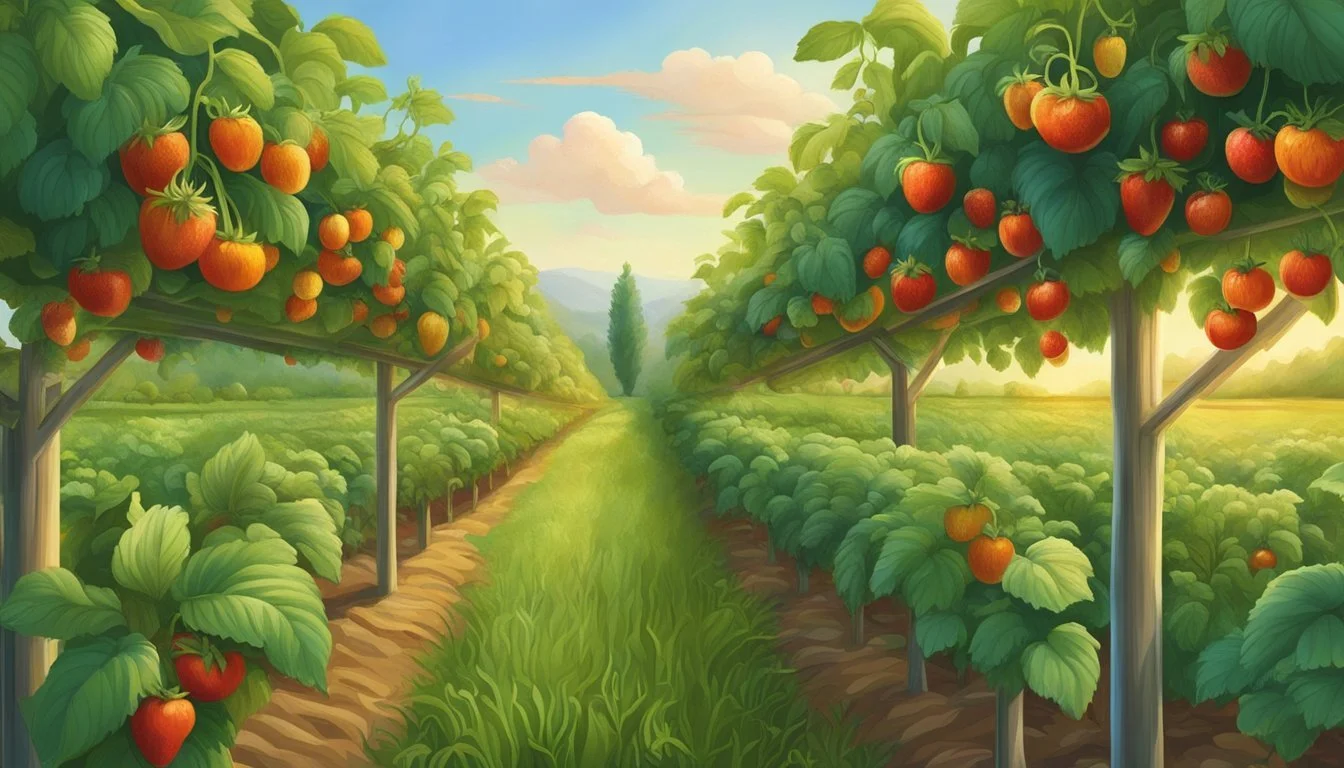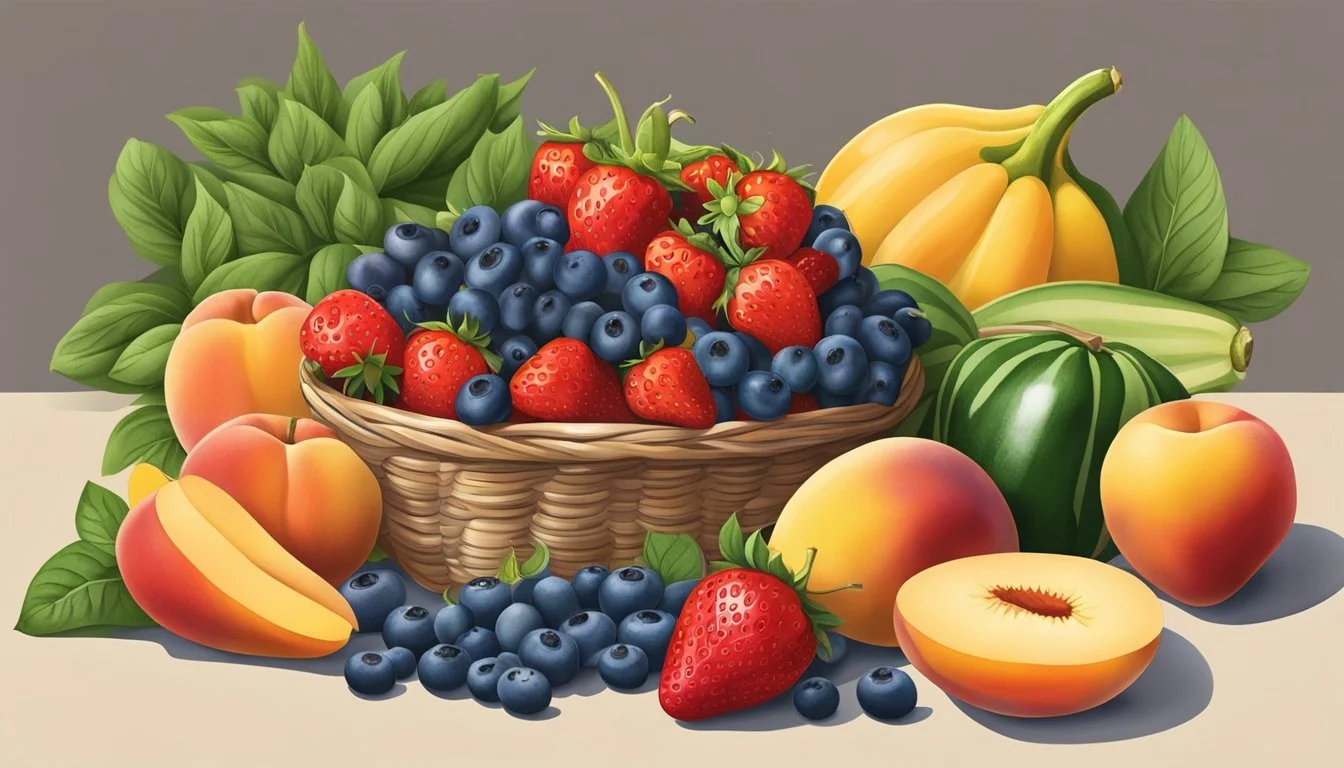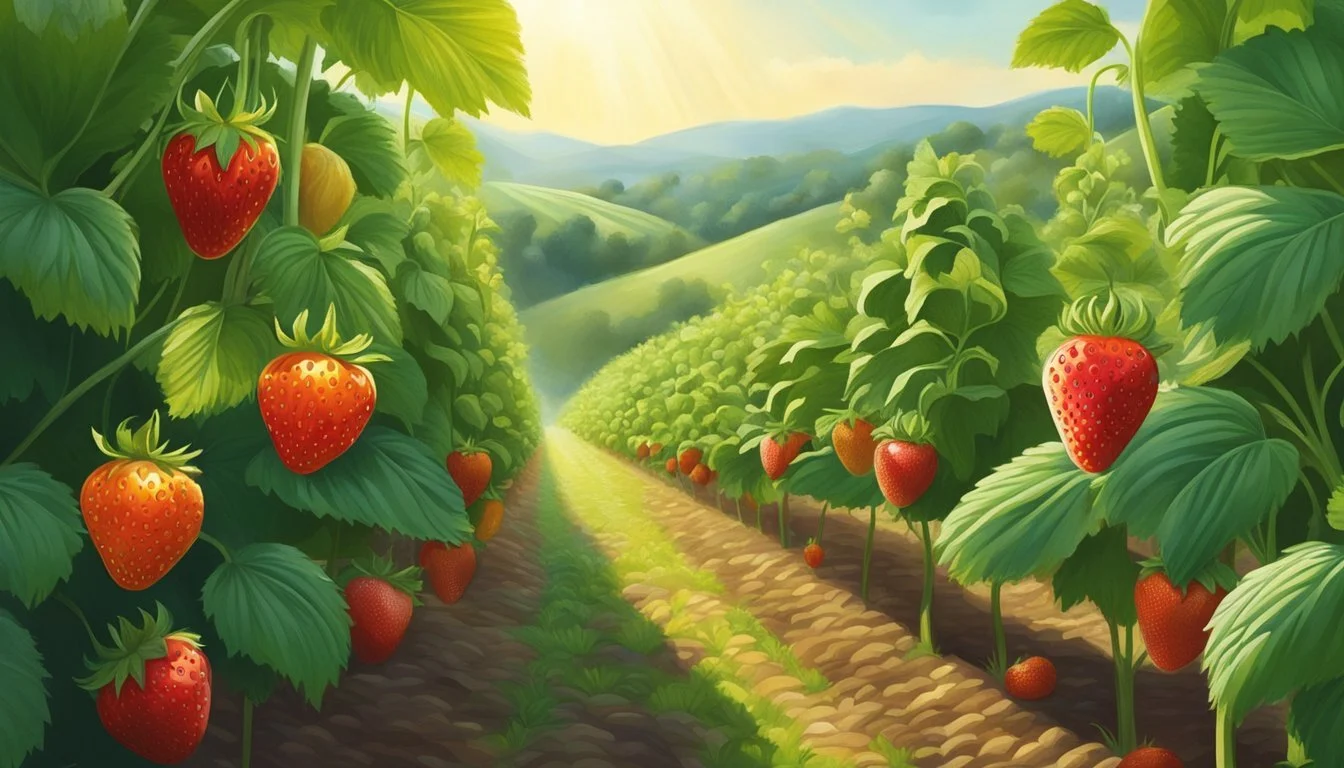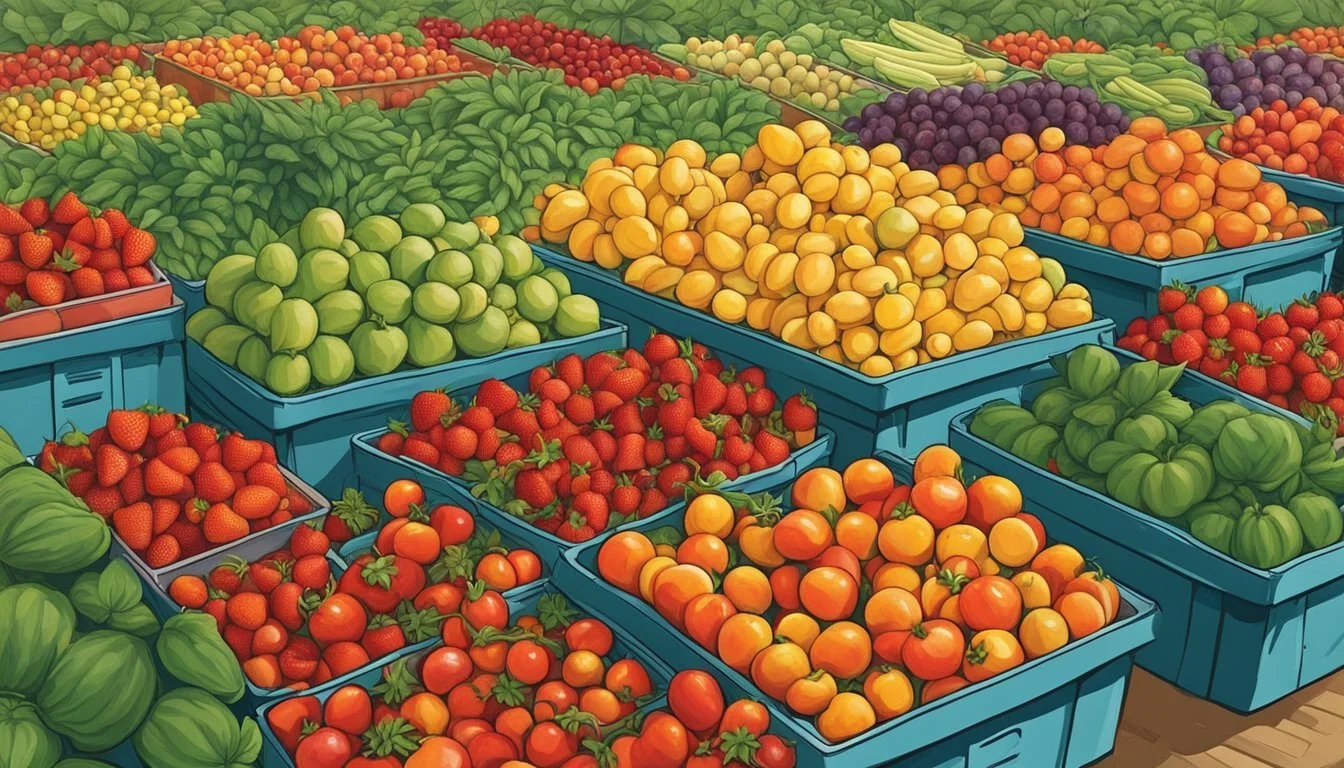Missouri Seasonal Fruit & Vegetables in June
Your Guide to Fresh Produce
This Article is Part of our Missouri Seasonal Fruit & Veg Calendar
June in Missouri brings a bountiful selection of fresh produce, marking a period where the fields and farms are rich with a diverse assortment of fruits and vegetables. This is the prime time for residents and chefs alike to take advantage of the seasonal availability of locally grown produce. The climate and soil of Missouri offer an ideal environment for growing a variety of crops, which results in an abundance of fresh, flavorful, and nutritious options throughout the month.
During this month, shoppers find themselves surrounded by fresh harvest including leafy greens, vibrant berries, and a multitude of vegetable varieties. Farmers' markets and local grocers brim with robust offerings such as luscious blackberries (how long do blackberries last?) and blueberries, juicy tomatoes, and crunchy cucumbers (how long do cucumbers last?). The Missouri growing season is in full swing, ensuring that many produce items are at their peak of freshness and taste.
By choosing local, seasonal produce, Missourians not only enjoy the freshest flavors but also support sustainable agriculture and regional farmers. In doing so, they contribute to the local economy and reduce the environmental impact associated with long-distance food transportation. Seasonal eating in June is an opportunity to celebrate the rich agricultural tapestry of the state and experience the true taste of Missouri's seasonal rhythm.
The Climate of Missouri in June
June in Missouri marks the transition from spring to summer, bringing changes in temperature and weather patterns. These alterations directly influence the quality of produce harvested during this month.
Temperature and Weather Patterns
Missouri experiences a significant shift in climate as June ushers in the start of the summer season. Average temperatures typically range from lows of 60°F to highs around 85°F. The state often encounters a mix of sunny days and occasional thunderstorms due to the rising heat and humidity.
Highs: Approximately 85°F
Lows: Approximately 60°F
Conditions: Sunny to partly cloudy with sporadic thunderstorms
Impact on Produce Quality
The warm temperatures and varying weather of June have a decisive impact on the quality of produce. Heat encourages the growth and ripening of fruits and vegetables, whereas heavy rains can affect plant health and soil conditions. Here's how the climate can influence some specific produce:
Tomatoes: Require consistent warmth; too much rain can lead to splitting.
Strawberries: Prefer cooler conditions; extreme heat can reduce sweetness.
Leafy Greens: Grow best in the mild temperatures of early June.
Farmers must be vigilant to protect their crops from weather extremes to ensure harvests are bountiful and of high quality.
Seasonal Produce Availability
In June, Missouri's harvest calendar reflects a bountiful availability of fresh produce. Consumers have the opportunity to enjoy a variety of fruits and vegetables at their peak season.
Vegetables in Season
During the month of June, the following vegetables can be readily found across Missouri:
Chard: Spanning its season from May through September.
Cilantro: Fresh from June through September.
Corn: Sweet corn starts to come in by mid-June and lasts through mid-August.
Cucumbers: Ready to pick from July, they're just beginning to appear by late June.
Green Beans: Their season kicks off in July, but early varieties may be available in late June.
Fruits in Season
The fruit harvest in June includes a tantalizing range of options:
Cherries: Pick the sweet varieties in June and July.
Peaches: While they peak later in summer and fall, the early varieties start to become available in June.
Garlic Scapes/Green Garlic: These are typically harvested in May and June.
Grapes: Awaiting their peak in August and September, early varieties may be sampled in June.
The above lists offer a guide to the peak periods of availability within Missouri, aiding in the selection of the freshest local produce during the month of June.
Missouri Harvest Calendar
The following outlines what one can typically find ready to harvest on a Missouri farm or local market during the month of June. The state's diverse climate allows a variety of fruits and vegetables to thrive, providing fresh and flavorful options for consumers.
Early June Harvest
In early June, Missouri farms begin to yield a selection of both fruits and vegetables. Consumers can look for:
Fruits:
Strawberries
Cherries
Vegetables:
Spring onions
Radishes
Lettuce
Spinach
Mid to Late June Harvest
As June progresses, the variety expands, with the following typically becoming available:
Fruits:
Blackberries
Blueberries
Peaches
Vegetables:
Beets
Carrots
Cucumbers
Green beans
Kohlrabi
Summer squash
Zucchini
Residents and visitors alike are encouraged to explore local farmers markets to find the freshest produce and support regional agriculture. The above lists serve as a guide for the typically available produce, but local conditions such as weather may affect availability.
Choosing and Storing Produce
In June, Missouri offers a variety of fruits and vegetables at the peak of freshness. The key to enjoying these seasonal offerings is knowing how to select the best quality and understanding proper storage techniques to extend their shelf life.
Selecting Quality Fruits and Vegetables
When visiting local markets, look for fruits and vegetables that have a firm texture, vibrant color, and a fresh smell. These are indicators of quality and freshness. Here are specific tips for some of June's produce:
Cantaloupes (how long does cantaloupe last?): Should be heavy for their size with a sweet, fragrant aroma at the stem end.
Cabbage: Look for heads that are dense and heavy with crisp, tightly packed leaves.
Snow peas: Pods should be bright green, crisp, and free from spots.
Preservation and Freezing Methods
Proper preservation methods are crucial for maintaining the nutritional value and flavor of fruits and vegetables. Freezing is an excellent way to preserve produce while retaining most of the quality.
Cantaloupes: Cut the fruit into chunks or balls, freeze on a baking sheet, and then transfer to airtight containers or freezer bags.
Cabbage: Blanch chopped cabbage for about 1.5-2 minutes, cool in ice water, drain, and freeze in airtight containers or bags.
Snow peas: Trim ends, blanch for 1-2 minutes, then cool, drain, and freeze flat on a tray before storing in freezer bags.
For optimal storage, ensure your freezer is set at 0°F (-18°C) or below. Label freezer bags with the date of freezing to keep track of freshness.
Health and Nutrition
Eating seasonally in Missouri during June provides an array of health and nutritional benefits. Seasonal fruits and vegetables tend to have higher nutritional value, which can positively impact one’s diet and health.
Dietary Benefits of Seasonal Eating
Seasonal produce is harvested at its peak of freshness, which means higher levels of vitamins and antioxidants. These nutrients are crucial for maintaining good health and preventing chronic diseases. For example, the vitamins found in leafy greens and ripe berries are often at their highest when these foods are in season. Additionally, seasonal eating aligns with the body's nutritional needs; in summer months like June, lighter foods such as leafy vegetables and fruits complement the body's dietary habits by providing hydration and essential nutrients without being overly heavy.
Incorporating Fresh Produce into Meals
For families in Missouri, the abundance of fresh fruits and vegetables in June can lead to more diverse and flavorful meals. Fruits such as berries and melons add a natural sweetness to breakfasts and desserts, while vegetables like tomatoes and cucumbers can be the backbone of salads and light entrées, perfect for the warmer weather.
Incorporation methods include:
Salads: Fresh greens, herbs, and sliced vegetables with a light vinaigrette.
Smoothies: Blend seasonal fruits with yogurt or milk for a nutritious snack.
Grilling: Vegetables like zucchini and peppers take on a rich flavor when grilled.
Snacking: Sliced raw vegetables or fruits make for healthy on-the-go options.
By focusing on seasonal foods, families can also see a reduction in their food bills as these items are often more affordable when they are in abundance. Seasonal fruits and vegetables typically require less transportation and storage, leading to lower costs and a fresher product.
Agricultural Practices in Missouri
Missouri farmers embrace a blend of traditional and modern agricultural techniques to ensure a sustainable and productive harvest. The region’s commitment to eco-friendly practices and effective pest control measures is essential for the success of its diverse crop yields in June and beyond.
Sustainable Farming Techniques
Missouri's agricultural community implements various sustainable farming techniques to preserve the state's rich soil and natural resources. Key practices include:
Crop Rotation: Farmers in Missouri often employ crop rotation to maintain the soil's fertility and to prevent the depletion of key nutrients.
Cover Crops: The use of cover crops, such as clover or hairy vetch, is common. These plants add organic matter to the soil, prevent erosion, and suppress weeds.
Farmers also consider frost dates and utilize cold frames and row covers to protect tender plants, ensuring that the gardens thrive from the potential late frost events in early June.
Pest and Disease Management
Missouri's farmers face challenges with pests such as the Japanese beetle, which can cause significant damage to crops. To combat these pests, they rely on:
Integrated Pest Management (IPM): IPM strategies reduce pest populations while minimizing environmental impact. Tactics include monitoring pest levels, biocontrol options, and judicious use of pesticides.
Regular Scouting: Farmers routinely monitor their fields for signs of pest and disease to tackle issues promptly before they escalate.
By strategically managing pests and diseases, Missouri's farming community safeguards their gardens and maintains high-quality produce throughout the growing season.
Gardening and Farm Planning
Missouri gardeners utilize strategic planting schedules to ensure robust vegetable yields across the state's varied hardiness zones. They plan meticulously, understanding that success in the garden heavily depends on timing and knowledge of their specific region.
Planting Schedules and Zones
In Missouri, the garden planting schedules adjust according to the designated USDA Plant Hardiness Zones. The state spans predominantly across zones 5 to 7. Gardeners in Zone 6 and Zone 7 should refer to the month of June as a transitional period. Here's a snapshot of what could be considered for planting:
Zone 6:
First Week: Cucumber, winter squash
Second Week: Pumpkin
Zone 7:
First Week: Sweet potatoes, okra
Second Week: Last call for green beans
Each specific crop has an ideal time frame for planting, varying slightly between the zones. Thorough planning helps professionals and hobbyists alike prepare for both a fruitful summer and the upcoming fall crops.
Maximizing Harvest Yields
For a successful vegetable garden, Missouri farmers make every effort to maximize their yields. This includes:
Soil Preparation: They ensure the soil is well-aerated, nutrient-rich, and properly moistened before planting.
Watering: Consistent moisture is key, especially when seeds are germinating or when plants are setting fruits.
Spacing: They give each plant enough space to grow to its full potential, reducing competition for water and nutrients.
Succession Planting: They plant in waves to extend the harvest period and avoid having too much produce maturing at once.
Fall Crop Planning: Gardeners in Missouri also plan for fall crops, which can include spinach and lettuce, by preparing portions of their garden to transition from summer-season produce.
By engaging with these practices, they aim to achieve the highest yield from their garden, optimizing each planting season from spring into the fall.
Local Food Scenes and Events
In June, Missouri buzzes with local food events and an abundance of fresh produce available at farmers' markets and through community-supported agriculture programs. These platforms not only offer access to seasonal fruits and vegetables but also serve as social and cultural gatherings, reflecting the state's commitment to agriculture and community engagement.
Farmers' Markets and Festivals
Farmers' Markets across Missouri become vibrant hubs in June, showcasing the state's seasonal bounty. Visitors can find a variety of produce freshly harvested and ready for the table. Notable markets include:
St. Louis:
Tower Grove Farmers' Market: Offers a diverse array of local fruits, vegetables, and artisanal foods.
Soulard Market: Known as one of the oldest markets in the state with a rich selection of local goods.
City Market: Hosts a large weekend farmers' market, where local farmers and businesses converge.
Festivals also play a significant role in celebrating the seasonal harvest. Events such as the Vaile Strawberry Festival underscore the state's love for local, seasonal eating, often featuring local farm stands, food vendors, and family-friendly activities.
Community Supported Agriculture
Community Supported Agriculture (CSA) programs in Missouri provide residents with a means to directly support local farms while receiving a share of the freshest seasonal produce.
Some CSA options include:
EarthDance Farms: Offers organic produce subscriptions with pickup options in and around the St. Louis area.
Fair Share Farm, LLC: Features various subscription plans for individuals and families, delivering to Kansas City and surrounding communities.
These programs bolster local economies and foster a sense of community through shared commitment to sustainable and local agriculture within the state.
Conclusion
The array of fruits and vegetables available in Missouri in June is diverse and plentiful. Consumers can enjoy fresh produce that ranges from sweet, succulent berries to crisp, leafy greens.
Seasonal Availability:
Berries: Strawberries and blackberries begin their peak season, offering rich flavors and nutritional benefits.
Greens: A variety of greens like lettuce and spinach are at their best, perfect for salads.
Vegetables: Roots like beets and carrots, as well as cruciferous vegetables like broccoli, are fresh and abundant.
Purchasing Tips:
Look for firmness and vibrant color in produce as indicators of quality.
Opt for local farmers' markets for the freshest selections.
When planning meals or shopping for groceries, consumers should take advantage of these seasonal offerings. They not only have a higher nutritional value but also support local agriculture and reduce the carbon footprint associated with long-distance transportation. June is an excellent month for Missourians to enrich their diets with a variety of locally-sourced produce.
To experience the full richness of what the Missouri harvest has to offer, referencing a seasonal calendar can be particularly useful. Eating seasonally ensures the freshest, tastiest, and most nutritious produce, elevating everyday dining to an enriching culinary journey.









